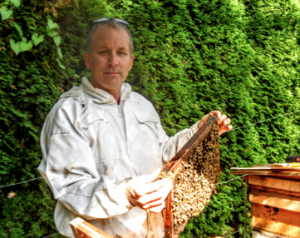01 Oct Interview with John Bach by Susan Koppersmith
John Bach, at the August 2016 Encountering Our Humanity conference in Ottawa you gave a workshop about your research on biodynamic beekeeping. What is your background and how did you become interested in bees?
I have been studying Anthroposophy for 25 years, gardening biodynamically for 15 years and for the last 8 years I have maintained beehives.
 What are some of the key elements of your research on bees?
What are some of the key elements of your research on bees?
Most readers have will have heard of the steady decline of the overall health of honeybees in the last 30 years. This has everyone very concerned. Scientists and beekeepers have blamed this decline on disease, mite infestations, the use of new pesticides on agricultural crops, as well as the potent chemicals applied to bees to control mite and fungi infestations. The effect of electro-magnetic radiation (EMR) so prevalent everywhere has also been studied. Interested readers can refer to a full description of these dangers in my article: A Biodynamic Understanding of the Decline of the Honeybee based on Indications Given by Rudolf Steiner which can be found on my website: bachbiodynamics.com
Of course all these things are true but Rudolf Steiner also gave another very important indication.
In a series of lectures entitled Nine Lectures on Bees (1923), Steiner predicted that within a century, if a current practice at that time did not change, the honeybee would be decimated within a century.
He was specifically referring to the method, which had only been in widespread practice for about a decade, of artificially raising queen bees by grafting worker eggs.
Do you mean that beekeepers changed things so that worker eggs become queens? Could you say more about this?
 Yes, this is the problem and it has had dire consequences.
Yes, this is the problem and it has had dire consequences.
The practice of artificially creating queens, refined by Gilbert M. Doolittle in the mid 1800s, came into widespread practice around the turn of the century. In this method, known as the Doolittle Method, four-day-old larvae, which are laid in horizontal hexagonal worker cells by the queen, are transferred (grafted) into vertical queen cups, which mimic the form and size of a naturally made queen cell. Sometimes a little royal jelly is placed in the cup with the larvae. These eggs are then placed in a small colony of bees in which the queen has been removed. The worker bees soon detect that the queen is not present (the queen emits a powerful pheromone) and begin at once to tend to the vertical larvae that are present in the hive and appear as queen cells.
In this way, a beekeeper can produce dozens or even hundreds of queens within a short period of time.
This method has tremendous advantages for beekeepers and is the foundation upon which modern beekeeping rests. Beekeepers don’t have to wait for the colony to make its own queens, which it does when it is preparing to divide through swarming, or when a queen is old and failing. Newly grafted queens can be used to make many new colonies by placing each of the new queens into a new hive with two or three pounds of worker bees.
Steiner’s research, however, indicated that when a queen lays an egg as a queen, it is meant to be a queen. This is what Nature intended.
When eggs laid initially as workers are then grafted into queen cells, these eggs do become queens. But the etheric forces of these artificially made queens become weak and this weakness is carried into the hives of future generations. This is the reason why honeybees are so susceptible nowadays to the diseases and mites and fungi, etc. mentioned earlier. The hives are no longer strong enough to withstand pathogens.
My research is focused on creating lineages of non-grafted queens as well as allowing bees to swarm more frequently using smaller hives.
I currently have four colonies with fourth generation natural, non-grafted queens, two of which are in small skeps (straw or wicker beehives) which swarm frequently (up to three times per year).
These colonies are very strong and healthy. I feel that I am now ready to expand my small operation in Vancouver to a larger scale and hope to have up to fifty non-grafted, lineage colonies in the next three to five years.
 This is a homemade skep that swarmed three times this year. It was made from a basket bought on craigslist
This is a homemade skep that swarmed three times this year. It was made from a basket bought on craigslist
Do any mainstream scientists and beekeepers know about this danger of grafting queens?
As far as I know there are no mainstream scientists or beekeepers who know enough about Steiner’s ideas to take them seriously. I believe that the problems we now see with bees will escalate dramatically over the next decade.
This is why I am so passionate about getting the word out that for honeybees to become healthy again, it is of up-most importance that bees be allowed create their own queens.
Good luck, John, and thank-you for your time!

Marian Baghor
Posted at 08:58h, 04 DecemberThank you very much, for a clear explanation and confirmation that grafting, or rather “tinkering” with life and living beings always creates disbalance and problems, in the short and long run. It’s for the first time that I can get it completely, why bees have gone into decline. If we’re not vigilant, human beings will be exposed to the same “tinkering”.
Hopefully the awareness of their high purpose and value, plus reverence for their nature and essence as pollinators, these exquisite beings capable of doing their dance in the air, showing directions to others, will increase and grow.